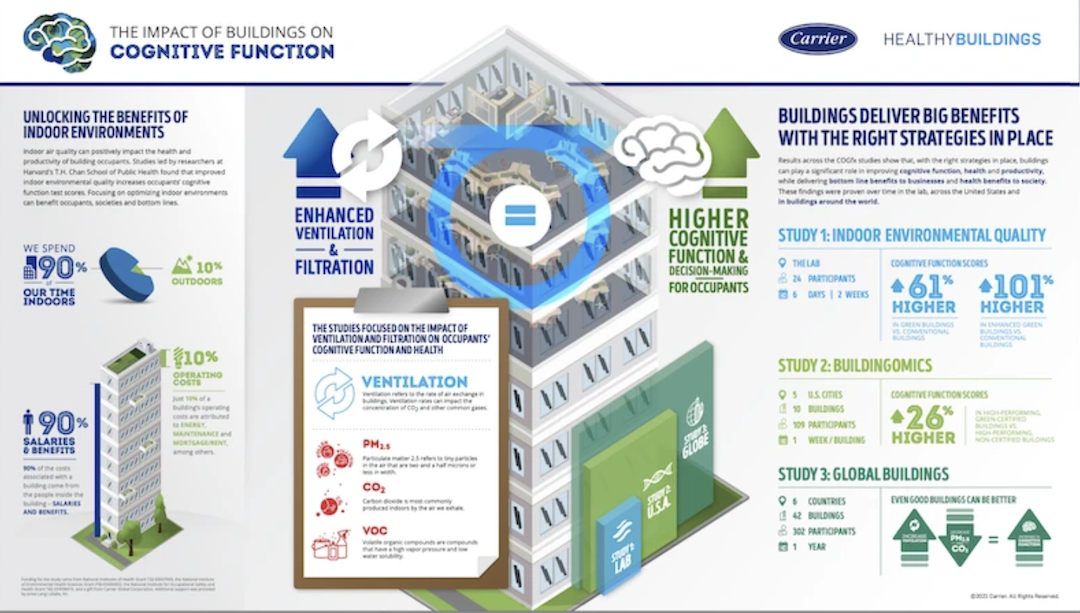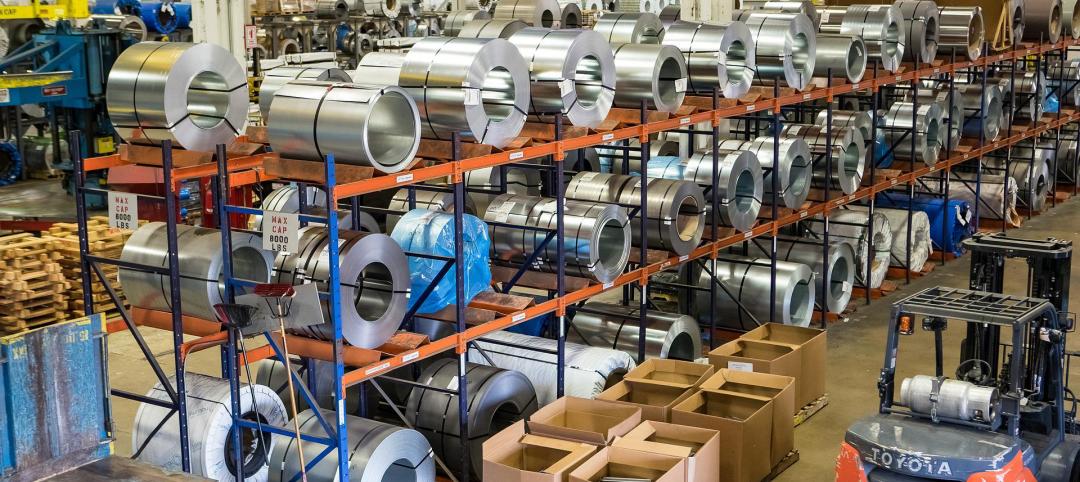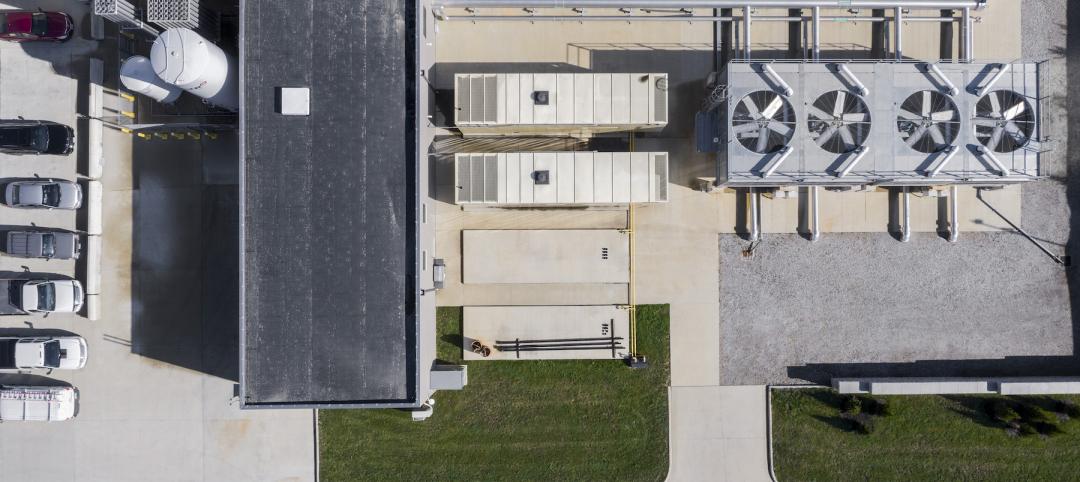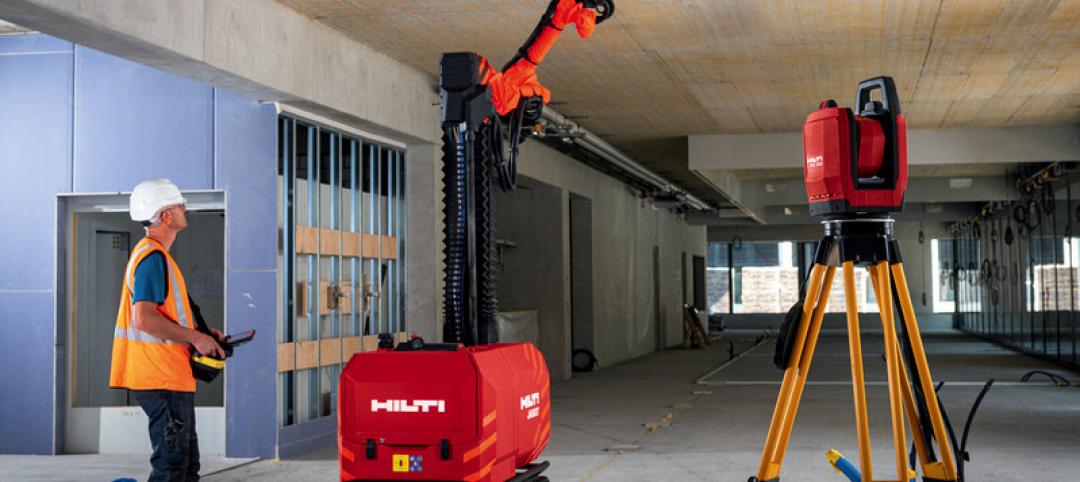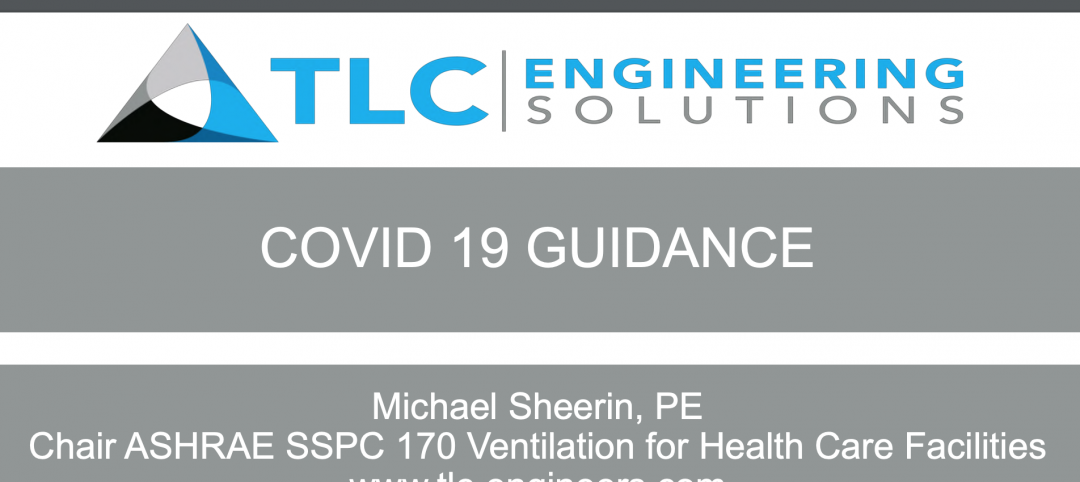Enhanced ventilation and filtration can improve the cognitive function and health of a building’s occupants, and should be the preeminent strategy for healthy buildings.
That’s the conclusion of COGfx Study 3: Global Buildings, new research by the Harvard T.H. Chan School of Global Health, which has been investigating the relationship between indoor air quality and cognitive performance since 2014. The latest study is the first to take a global approach, encompassing 302 office workers in 42 buildings across 30 cities and six countries—China, India, Mexico, Thailand, the United Kingdom, and the U.S.
This study builds upon and corroborates two previous research projects that the T.H. Chan School had conducted over the past several years. The first tested 24 lab workers for six days over two weeks and found 61% higher cognitive scores among those in green vs. conventional buildings, and 100% higher scores in enhanced green buildings. The second tested 109 participants in 10 buildings and five U.S. cities over a week’s time, and recorded 26% higher cognitive scores among those people in green-certified buildings vs. high-performance but non-certified buildings.
The latest, more expansive, study tracked occupant performance over 12 months. The study concluded that occupants’ cognitive function improves by increasing a building’s ventilation (i.e., the rate of air exchange) in ways that reduce its interior inhalable particulates (PM2.5 specifically) and carbon dioxide (CO2)
The third study, whose findings were released last week, used real-time environmental sensors (including wearable monitors) and a customized Harvard Healthy Buildings mobile app to collect data and administer momentary assessments of cognitive function, health, and occupant satisfaction.
IAQ IS NOW CRITICAL TO INTERIOR DESIGN
Even small effects of cognitive function and health can translate into substantive short- and long-term benefits, the study reports. “When you consider that 90% of the costs in a building are associated with the people inside, including salaries and benefits, the ability to improve cognitive performance and reduce infectious disease transmission, sick building symptoms, and missed workdays through improved air quality is powerful.”
As more people return to their workplaces and schools after prolonged pandemic quarantines, “the health, safety, and intelligence of indoor environments have come into greater focus,” says Dave Gitlin, Chairman and CEO of Carrier, the HVAC supplier which provided a gift to help fund this research. “The COGfx Study continues to demonstrate that proper ventilation and filtration of indoor environments play important roles across the globe in fostering a proactive health strategy.”
Carrier’s Healthy Buildings Program, which serves several typologies, offers innovations that include a digital, cloud-native platform for aggregating data from different systems and sensors; OptiClean, a portable negative air machine; and Indoor Air Quality assessments for devising health building strategies.
Funding for the Harvard study also came from the National Institutes of Health, the National Institute of Environmental Health Sciences, and the National Institute for Occupational Safety and Health. JLL provided additional support.
Related Stories
Building Materials | Jun 20, 2022
Early-stage procurement: The next evolution of the construction supply chain
Austin Commercial’s Jason Earnhardt explains why supply chain issues for the construction industry are not going to go away and how developers and owners can get ahead of project roadblocks.
Multifamily Housing | Apr 7, 2022
Ken Soble Tower becomes world’s largest residential Passive House retrofit
The project team for the 18-story high-rise for seniors slashed the building’s greenhouse gas emissions by 94 percent and its heating energy demand by 91 percent.
M/E/P Systems | Jan 27, 2022
Top 5 building HVAC system problems and how to fix them
When your HVAC system was new, it was designed to keep the indoor environment comfortable, functional, and safe. Over time, that system can drift out of alignment, leading to wasted resources, excessive energy consumption, and reduced occupant comfort.
AEC Tech | Oct 28, 2020
Meet Jaibot, Hilti's new construction robot
The semi-autonomous robot is designed to assist MEP contractors with ceiling-drilling applications.
Building Team | Aug 21, 2020
A healthcare project in Wisconsin benefits from including MEP subs in early design discussions
Prefabrication played a major role in quickening construction.
Coronavirus | Apr 1, 2020
TLC’s Michael Sheerin offers guidance on ventilation in COVID-19 healthcare settings
Ventilation engineering guidance for COVID-19 patient rooms
Sponsored | HVAC | Feb 3, 2020
Reliable Building Systems Increase Net Operating Income by Retaining Tenants
Tenants increasingly expect a well-crafted property that feels unique, authentic, and comfortable—with technologically advanced systems and spaces that optimize performance and encourage collaboration and engagement. The following guidance will help owners and property managers keep tenants happy.
Sponsored | HVAC | Jan 6, 2020
Four Ways Building Systems Create Long-term Profitability
When accounting for the total cost of ownership and the potential return on investment, owners and developers should consider total energy usage, the lifespan of building systems equipment, the recruitment and retention of occupants, and lease rates.
Sponsored | HVAC | Jan 6, 2020
Maximize Energy Efficiency in Class A Office Buildings With Modern Building Systems
Energy-efficient building design starts with the building envelope, but the building systems have a tremendous impact on energy use as well.
75 Top Building Products | Dec 16, 2019
101 Top Products for 2019
Building Design+Construction readers and editors select their top building products for the past 12 months in the fourth-annual 101 Top Products report.


